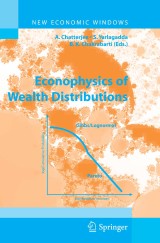Details

Econophysics of Wealth Distributions
Econophys-Kolkata INew Economic Windows
|
CHF 59.00 |
|
| Verlag: | Springer |
| Format: | |
| Veröffentl.: | 25.06.2007 |
| ISBN/EAN: | 9788847003897 |
| Sprache: | englisch |
| Anzahl Seiten: | 248 |
Dieses eBook enthält ein Wasserzeichen.
Beschreibungen
We all know the hard fact: neither wealth nor income is ever uniform for us all. Justified or not, they are unevenly distributed; few are rich and many are poor! Investigations for more than hundred years and the recent availability of the income distribution data in the internet (made available by the finance ministries of various countries; from the tax return data of the income tax departments) have revealed some remarkable features. Irrespective of many differences in culture, history, language and, to some extent, the economic policies followed in different countries, the income distribution is seen to fol low a particular universal pattern. So does the wealth distribution. Barring an initial rise in population with income (or wealth; for the destitutes), the population decreases either exponentially or in a log-normal way for the ma jority of 'middle income' group, and it eventually decreases following a power law (Pareto law, following Vilfredo Pareto's observation in 1896) for the rich est 5-10 % of the population! This seems to be an universal feature - valid for most of the countries and civilizations; may be in ancient Egypt as well! Econophysicists tried to view this as a natural law for a statistical ma- body-dynamical market system, analogous to gases, liquids or solids: classical or quantum.
Data and analysis.- Pareto’s Law of Income Distribution: Evidence for Germany, the United Kingdom, and the United States.- Two-class Structure of Income Distribution in the USA: Exponential Bulk and Power-law Tail.- Pareto-Zipf, Gibrat’s Laws, Detailed-Balance and their Breakdown.- Empirical study and model of personal income.- Blockbusters, Bombs and Sleepers: The Income Distribution of Movies.- Models and theories.- Emergent Statistical Wealth Distributions in Simple Monetary Exchange Models: A Critical Review.- Lagrange Principle of Wealth Distribution.- Carnot Process of Wealth Distribution.- Ideal-Gas Like Markets: Effect of Savings.- Kinetic Theory Models for the Distribution of Wealth: Power Law from Overlap of Exponentials.- Detailed Simulation Results for Some Wealth Distribution Models in Econophysics.- Dynamics of Money and Income Distributions.- Dynamic Process of Money Transfer Models.- A Stochastic Trading Model of Wealth Distribution.- Wealth Distribution in a Network with Correlations Between Links and Success.- The Monomodal, Polymodal, Equilibrium and Nonequilibrium Distribution of Money.- Relieving Poverty by Modifying Income and Wealth Distributions.- The Rich Are Different ! Pareto Law from Asymmetric Interactions in Asset Exchange Models.- Do We All Face the Same Constraints?.- Related studies.- A Stochastic Model of Wealth Distribution.- How the Rich Get Richer.- Power-Law Distribution in an Emerging Capital Market.- Statistical Analysis on Bombay Stock Market.- Funds Management by Banks in India: Solution to a Persisting Optimization Problem.- Income Distribution in the Boltzmann-Pareto Framework.- Comments and Discussions.- Econophys-Kolkata: A Short Story.- Econophysics of Wealth Distribution: A Comment.- Econophysics of WealthDistributions: Workshop Summaries.
<P>Understanding the distribution of income and wealth in an economy has been a classic problem in economics for the last hundred years. Apart from the rapidly decaying number density of people with their income crossing over to a robust power law for the very rich, known as the Pareto power-law, after Vilfredo Pareto. With the availability of accurate data from finance/income-tax departments of various countries, several robust features of the income distribution have been established. </P>
<P></P>
<P>This field had been dormant for more than a decade, although accurate data had been accumulated over this period. The recent enthusiasm comes mainly from the physicists modelling of markets in analogy with physical systems like gases etc. This is the first book reporting exhaustively on these developments over the last decade by leaders in the field</P>
<P></P>
<P>The book will report on the major models developed mainly by the (econo-) physicists over the last decade. Almost all the major physicists and economists involved in these studies will review their latest work and the associated developments.</P>
<P></P>
<P>This field had been dormant for more than a decade, although accurate data had been accumulated over this period. The recent enthusiasm comes mainly from the physicists modelling of markets in analogy with physical systems like gases etc. This is the first book reporting exhaustively on these developments over the last decade by leaders in the field</P>
<P></P>
<P>The book will report on the major models developed mainly by the (econo-) physicists over the last decade. Almost all the major physicists and economists involved in these studies will review their latest work and the associated developments.</P>


















